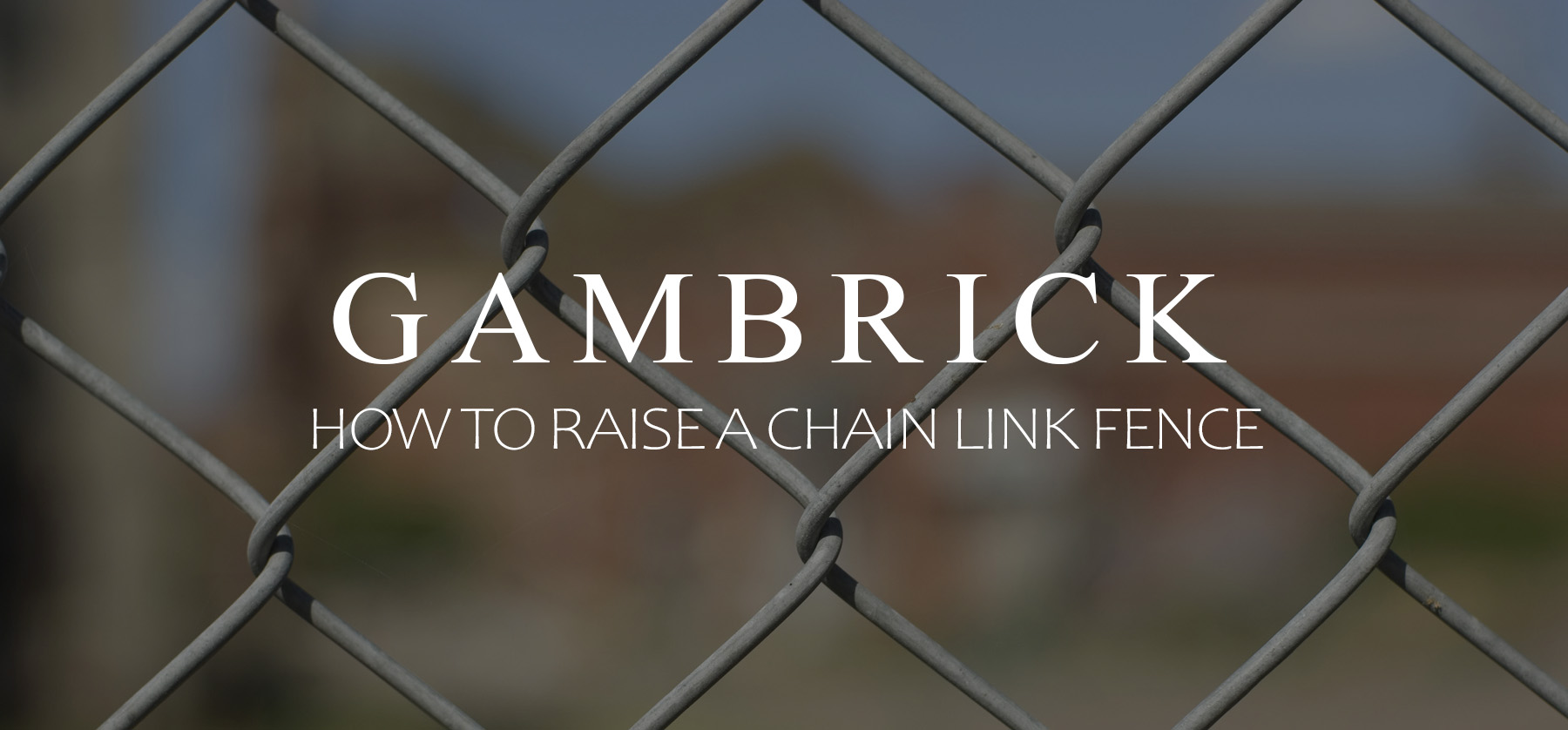How To Raise A Chain Link Fence
There are quite a few great ways to raise a chain link fence. Extending the height of your existing fence is much easier and cheaper than replacing the entire thing. Especially if all you need is another foot or two. Most methods install right on top of your existing fence and posts which saves time and money. However you will most likely have to raise your existing fence posts to give the fence it’s strength. Fence post height extenders are strong, durable and easy to install. Most make a great DIY project but I recommend raising the height of a fence with a partner. Especially if the fence is high. Working with a ladder can be dangerous. Once the fence posts are raised it’s easy to install a new fence section.
The first step in raising a chain link fence is almost always raising the posts first. They’re what gives a fence it’s strength and support. Take your time with this step because it’s crucial. Once the posts are at the correct height it’s easy to install a new fence section right on top of the old one.
Another method involves raising all the posts but replacing the old chain link. This costs a little more money but give the fence a more cohesive look because there’s no seam.
We’ll discuss every method we use to raise a chain link fences height below.
How Chain Link Fences Work
The standard height for a chain link fence is approximately 4 – 6 feet high. But we do build them much higher in certain situations. For example, the protective areas behind the hitter in baseball are generally made of chain link fencing as high as 20 feet. This is because chain link is strong, durable and easy to see through. High chain link fences are also used in areas that contain wild animals such as zoos or preserves.
If you’ve got the standard 4 foot high fence but want to extend the height to keep a large dog in, or some deer out, it’s easy to do.
The posts are generally set in concrete which makes it difficult and expensive to remove and replace them with longer posts. Even when posts are set in gravel or soil, they’re not that easy to remove and replace. Instead, you can simply extend the existing posts with longer posts in order to raise the fence height.
Taking Apart A Fence
In some cases you may have to take your fence apart in order to raise it’s height.
Remove all the fence material first. This could include fabric, rails and the chain link itself. When your all done, all you want are posts.
The fencing is typically attached to the posts and top rails with wire ties. These ties are easy to remove. Simply untwist them with a set of pliers.
A tension rod and tension bands are used to attach chain link fencing to the corner end posts. This what’s used when a chain link fence is stretched. Without these bands the fence would be loose and pretty useless. Removing the bolt from the tension band releases the tension rod and chain link fencing.
To remove the fence rail, loosen the brace bands from the line post caps, slide the rails out of the bands, and remove the rail caps from the sides of the end posts. Remove all the end post caps and line post caps.
There are three types of posts you’ll be working with.
- End. End posts sit at the end of the fence.
- Corner. Corner posts are at the corners.
- Line. Line posts are in the middle sections.
Measure the inside and outside diameter of the posts. Often times, posts will have different sizes based on where they are. For example, line posts usually have inside diameters of 1 5/8 inches, while corner and end posts have inside diameters of 2 3/8 inches.This is because end and corner posts carry more weight.
Count the number of line posts, corner posts and end posts in your fence.
Extending The Height Of Fence Posts
Raising the height of a chain link fence by using longer poles is easy to do. Once the fence is apart and all your poles are exposed, you can slide new posts right over the old ones.
Make sure the new posts are slightly larger in diameter than the existing posts.If you get a post that’s too small it won’t fit over the old one. Also make sure the new posts are the correct height. The inside diameter of the new post should be large enough to fit around the outside diameter of the old post.The fit probably won’t be perfect, so use some shims to make up the remaining small gap. I like the new posts to be super tight which prevents any movement.Use a level as you go.
Try not to go too high with this method. An old 4 foot post can easily support a new 6 foot one. But a 10 foot section of fence should get a new post freshly anchored in concrete.
Slide the longer, larger diameter fence posts over the shorter existing posts. The new posts should fit over the existing posts like a sleeve.
Push the longer fence posts all the way down to the ground. Use a rubber mallet if they don’t slide on easily.
Install the post caps, brace bands and fence rails onto the new posts. You’ll need to purchase new caps and brace bands because of the larger posts.
Attach new chain link fencing and fabric to the new posts and top rails.
Install new tension bands to the corner and end posts that are cut to the new fence height.
Lay the fencing on the ground and slide a tension bar through the links at the end of the sections. Slide the tension bar into the tension bands and secure them with the bolts. Everything you nee should come included with the tension bands.
Attach the fence to the top rail and line posts with aluminum tie wires spaced about 12 inches apart. Use a good set if pliers for this.
Tips
Once you secure the tension bar to the tension bands at the first corner or end post, use a hand crank fence puller to increase the tension in the chain link fencing. Without the proper amount of tension the chain link fence won’t work properly.
Once the fence section is stretched, attach it to the corner or end post on the opposite end of where you started.
Add tie wires to the top rail and line posts after attaching the fencing to the corner or end posts. Use a good set of pliers for this. They go on just like a twist tie you’d wrap around a plastic bag.
Run a tension wire through the chain links at the bottom of the fence from end to end. Tighten the wire and wrap it tightly around the end posts. This secures the bottom portion of the fence.
Extend The Height Of Your Fence With Welded Wire
A great way to add additional height to a chain link fence is with welded wire. This is one of the simplest and most affordable methods to extend the height of your fence because you don’t have to alter the existing fence. The welded wire bolts on.
Welded wire fencing is made by welding the intersections of the wire together. This helps create a strong, rigid structure that makes a great barrier. Welded wire is best used in short runs because it’s not easy to stretch tight like chain link is. This makes it a great solution if all you need is another few feet of fence height.
Because welded wire is made from solid wiring and welded together, it’s very strong. It’s sold in a roll and with different gauge wire. I recommend buying the thickest gauge. It’s stiffer and easier to work with.
Generally welded wire is used to build animal cages but it’s also great for extending the height of a chain link fence because it’s strong and weather resistant.
Welded wire also looks sort of like chain link because both are made from thin, round material. This makes it blend right in with the existing fence.
I recommend using galvanized wire because it’s weather resistant.
How To Install Welded Wire To A Chain Link Fence
Welded wire comes in a large roll, typically 50′ – 100′, so you’ll have to cut it to size. This means you’ll need a tape measure and some good wire cutters. Once you cut a section of wire to the correct size, you’ll need to secure it to the fence. For this I use more wire and some pliers. I twist the connecting wire tight just like how you install a chain link fence.
I recommend also raising the posts along with adding welded wire to increase the fences height. Extending the height of your fence posts gives some more areas to secure the welded wire too which adds a ton of additional strength. Without higher posts the welded wire won’t be very strong.
T posts are another great way to add height to the fence while supporting the welded wire.
U-channel is a great way to build a frame around the welded wire sections. It looks nice and provides even more strength. Simply cut the u-channel to size and place it around the wire. Secure sections of channel together with stainless steel or galvanized screws.
If your worried about animals getting out of your yard then you can bend the top of the welded wire inward. I recommend a 45 degree angle. This makes the fence very hard to jump over and typically discourages animals from even trying. Although the flatter area becomes a great place for birds to rest.
Mesh Cloth
Mesh cloth is another great way to extend the height of your chain link fence. It works in much the same way as welded wire only it’s not as stiff.
Mesh cloth, a.k.a. hardware cloth, is wire mesh that consists of either woven or welded wires in a square or rectangular grid. Hardware wire cloth mesh is available in galvanized steel, stainless steel, plastic and bare steel. What makes it different from welded wire is the gauge. Mesh cloth is much thinner than welded wire. This makes it cheaper and easier to work with for some projects. Although it’s flimsy so it needs a lot of support. Welded wire is strong so it can generally support itself. Especially if the wire is a thick gauge.
I’ve had the best results with mesh cloth when using along with a strong frame. I don’t recommend using the cloth all by itself to add height to your fence. It’ll be flimsy and fall right over. It’ll also look really bad. In order for metal fencing like chain link, welded wire or mesh to look it’s best, the material has to be stretched tight. This means you need strong support.
How To Raise A Chain Link Fence’s Height With Mesh Cloth
The first thing I recommend you do is build a frame. For this I like to use lengths or round steel or rebar. For example, if your raising a 6 foot section of chain link fence a foot, you’ll need 4 sections of tubing. 2 cut at 6 foot and 2 at 1 foot. Secure them together at the corners. The method you use to secure the corners will vary based on the frame material you use.
Once the frame is built, stretch the mesh cloth over the frame and secure it with wire. Alternate side to keep the mesh tight. This is sort of like installing a roll screen. The cloth mesh itself makes the frame much stronger.
After the frame is built and the mesh is installed. secure the section to the top of your chain link fence. To do this you’ll need vertical support. I recommend either extending the height of your posts with more tubing, using T posts or both. Vertical support is crucial. This is what give the new sections of fencing it’s strength.
Working with mesh cloth is easy. It comes in a roll, so the first thing you’ll need to do is unroll it. Only unroll about as much as you’ll need at any one time. Then cut the wire to size with some metal clipper. You’ll also need a tape measure and some pliers.
Balling wire is what I use to secure the mesh cloth to the frame and fence. This is what the pliers are for.
Just like adding welded wire, mesh cloth is a simple and affordable way to add additional height to your chain link fence. And it looks great if you take your time with the frames.
Wood
Another great material to extend the height of a chain link fence is wood. I like the look of a mixed material fence. Cold metal chain link on the bottom with some warm, natural wood on top looks really good. And because you’re working with wood, just about any creative design can work.
Generally I build frames out of wood just like I do with metal. 2x4s or 1x3s are great for this. You can even use scrap wood if you have some left over from another project. Cut the frames to size and screw them together with stainless steel or galvanized screws.
Once the frames are built, you can use just about any material to fill the void. Lattice works great.
Securing wood to a metal fence is actually pretty easy. Wood is strong so all you have to do is secure each end of the panel to the post. I recommend raising the posts to the desired height just as you would with other materials. Then screw the wood panels to the posts. Since your working with wood now you can raise the height of the fence posts with wood too. This way the top of all your fencing will match.
Trellis
One of my favorite ways to raise the height of a chain link fence is with a trellis. I love the looks of vine plants growing on a fence. They can be beautiful to look at and provide some more privacy where you want it. In some areas you’re not allowed to have a solid fence but plants are generally OK.
I like to build my trellis out of wood but you can use wood, metal, plastic or a combination of materials. Lattice makes a great trellis if you build a strong frame to support it.
Once your trellis panels are built, secure it to the top of the fence just as you would with other fence raising methods.
An additional benefit to building a trellis is that vine plants need virtually no maintenance. They’re a wild plant that generally takes care of itself. As long as they’re able to survive in the environment you plant them in there’s nothing for you to do once they start growing. I do like to guide the vine up to where I want it though but after it takes hold they don’t need maintenance.
Vines can get heavy as they grow so make sure you build those trellis panels strong and secure them tightly.
Tenax Fencing
Another great material for adding height to a chain link fence is called Tenax. It’s pretty much the same basic material as welded wire or mesh cloth only it’s made from plastic.Although because it’s plastic and kind of flimsy I only use it short term. In my opinion it’s not a great permanent way to raise the height of a fence.
Plastic roll fences are made from polypropylene. They undergo a special process called molecular orientation where their threads are run in two directions. This process increases tensile strength which makes it great as a fence material. Tenax is easy to work with, durable, weather resistant and cheaper than metal roll fencing.
One of the advantages to using a plastic material is that it’s softer than metal. There are no sharp edges or protruding wire that can stick or cut you. On the other hand it’s softness makes it flimsy which means you need to build support.
Just as with cloth mesh, I recommend building a frame to support the Tenax as well as raising the fence posts. It pretty much installs exactly the same as mesh cloth so I’m not going to go over the entire process again.
Tenax comes in a variety of colors.
I don’t like using Tenax as a permanent way to raise the height of a chain link fence. It doesn’t look as good as metal roll fencing and won’t last as long. Although for the short term it’s a great solution that’s cheap. I use it a lot as a temporary barrier when building or renovation homes.
More Chain Link
Another great way to extend the height of a chain link fence is with more chain link.
To add another chain link section to the top of an existing fence you need to extend the posts first. Chain link sections are entirely supported by the posts so they need to be the correct height and very strong.
When you stretch a chain link fence it creates a lot of pressure so those post extensions have to be secure. What I like to do is install a long PVC or metal tube down into the old post and up into the new post extension. This is a great way to bond the two pieces together into one very strong post.
Once the posts are all the correct height, simply install the new chain link section right on top of the old one.
Here’s a tip. Make sure the links line up. If they don’t it’ll stand out that your using two sections of chain link stacked on top of each other. By lining up the links you may not even notice. Especially from afar.
How To Extend The Height Of Hollow Fence Posts
Almost every method we use to extend the height of a chain link fence involves raising the fence posts. Raising the height of your posts gives strength and stability to the new section of fence that sits on top of the existing fence. Without higher posts, it’s hard to support the new top section. Luckily it’s pretty easy to do and doesn’t involve replacing the old posts.
What I like to do is use new PVC or steel tubing. I install the tubing inside the old post and to the desired height.
For example, lets say you have a 4 foot high chain link fence but want to raise the height to 6 foot. I would cut 6 foot PVC or steel tubing and insert them into the old posts. This means 4 foot is inside the existing post and 2 foot is exposed on top. Then I cover the exposed 2 foot with metal post to match the old fence posts. I you do it carefully the seam is almost unnoticeable. The 4 foot that runs down into the old post provides a lot of strength and support to the new 2 foot section on top.
Install the cap onto the new 6 foot high post.
I also like to run some silicone at the seam. This keep water from penetrating into the fence post.
Keep in mind that this method only works if your posts are hollow. To extend the height of solid posts I have a technique we’ll discuss next.
Below are some step by step instructions detailing how I raise chain link fence posts.
Measure & Count The Posts
The first step in any construction project is planning. Measure the height of your existing posts and then determine how high you ultimately want them to be. This measurement will help when you’re buying material.
Also count how many fence posts you’ll be extended. Make a list of everything you need.
Take your time when planning out your materials. If it involves special ordering this could save you a lot of time, money and stress.
Buy Materials
This is why careful planning and counting is important. When it comes time to do the job you don’t want to be running out to Home Depot every hour to buy something. And if your project involves ordering parts online, not having what you need could set you back weeks.
Also make sure you have all the tools you’ll need. This could also cost you a lot of time and money. One of the reasons why pros always seem to make projects look easier is because they have all the tools they’ll need.
Remove The Old Fence Caps
First, you will need to remove the old fence cap to expose the hollow center of the post. Be careful when removing the caps because they may be glued on.
If the post caps won’t come off, a grinder will come in handy. Generally fence post caps are made from thin metal that’s easy to grind off. The grinder is also good at cleaning off old glue.
Install Center Piping
Once the hollow center of the fence post is exposed, cut PVC or steel piping to the desired height and slide it into the old post.
Make sure your new tube is just slightly small enough to fit into the old post.
Once the new tub is inserted into the post I use some shims to keep it tight.
Install New Top Post
After the new center tube is installed I slide the new fence post section on top.
This method creates a seam so use some silicone to seal it. Silicone will prevent water from slipping into the post.
Use shims to keep the new post tight against the inner tube. Without shims the new post could have some wiggle room.
Add the Cap
Once the top post is in place, install the cap.
Add the New Fencing
After your fence caps are on, it’s time to install the new sections of fence.
Tools
If your planning on raising the height of your chain link fence, you’ll need some tools. Here’s a list of tools and supplies we commonly use.
- Pliers
- Wrench
- Wire Cutter
- Tape Measure
- Level
- Hollow Metal Line Posts
- Hollow Metal Line Posts
- Rubber Mallet
- End Post Caps
- Line Post Caps
- Rail Caps
- Chain Link Fence Fabric
- Tension Bars
- Tension Bands
- Fence Puller
- Aluminum Tie Wires
Summary: How To Raise A Chain Link Fence
There are quite a few great ways to raise a chain link fence. Extending the height of your existing fence is much easier and cheaper than replacing the entire thing. Especially if all you need is another foot or two. Most methods install right on top of your existing fence and posts which saves time and money. However you will most likely have to raise your existing fence posts to give the fence it’s strength. Fence post height extenders are strong, durable and easy to install. Most make a great DIY project but I recommend raising the height of a fence with a partner. Especially if the fence is high. Working with a ladder can be dangerous. Once the fence posts are raised it’s easy to install a new fence section.
The first step in raising a chain link fence is almost always raising the posts first. They’re what gives a fence it’s strength and support. Take your time with this step because it’s crucial. Once the posts are at the correct height it’s easy to install a new fence section right on top of the old one.
Another method involves raising all the posts but replacing the old chain link. This costs a little more money but give the fence a more cohesive look because there’s no seam.
If you have any questions or comments about how to raise a chain link fence Email any time.





















